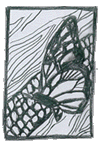Ecological Implications
Bt and Monarch Butterflies
What is Bt and What does it do?
 Bt (Bacillus thurnigiensis) is a naturally occurring bacteria that has been used as an insecticide to control caterpillars in the insect family Lepidopetera. The toxin affects young larvae more significantly than older larvae, either killing the larvae or severely limiting their growth. In 1996, Bt protein has been genetically engineered into various plant tissues (including pollen) to control larvae of the European corn borer, while limiting the use of more harmful pesticides. Right now, 30% of all corn crops contain Bt. Recently, however, studies have shown that Bt pollen can harm monarch butterfly larvae by spreading to milkweed plants, upon which they feed exclusively (http://ipcm.wisc.edu/wem/99-10Crops3.html).
Bt (Bacillus thurnigiensis) is a naturally occurring bacteria that has been used as an insecticide to control caterpillars in the insect family Lepidopetera. The toxin affects young larvae more significantly than older larvae, either killing the larvae or severely limiting their growth. In 1996, Bt protein has been genetically engineered into various plant tissues (including pollen) to control larvae of the European corn borer, while limiting the use of more harmful pesticides. Right now, 30% of all corn crops contain Bt. Recently, however, studies have shown that Bt pollen can harm monarch butterfly larvae by spreading to milkweed plants, upon which they feed exclusively (http://ipcm.wisc.edu/wem/99-10Crops3.html).
The Cornell Study
Cornell researcher John Losey and his colleagues collected corn pollen from botanical plants, some containing Bt. Then, with a spatula, they dusted moistened milkweed leaves with the different pollen types. Milkweed leaves without corn pollen were also included as a control group. Three-day-old monarch caterpillars were then placed on the leaves and were allowed to feed. The Cornell researchers found that after four day, 44 percent of the monarchs died that fed on the Bt-pollen-coated leaves. No caterpillars that consumed leaves with other pollen or the control leaves died. Those caterpillars that consumed Bt leaves and lived were less than half the size of larvae that fed on leaves with other pollen. One concern scientists have with this study is that the monarch larvae may have been fed excessive amounts of Bt pollen; however most scientists agree that some caterpillars that feed on milkweed covered with Bt pollen will be killed (VanDyk, pg.1).
Iowa State University Study
Iowa State University entomologist John Obrycki and a graduate student conducted a field study to examine Bt pollen effects on the monarch. They tested milkweed leaves at several distances from the field edge in a Bt cornfield and noticed the highest concentrations of pollen was found on plants within the cornfield. Samples were taken from the milkweed with and adjacent to the field, and were used to measure the mortality or newly hatched monarch larvae. Within 48 hours there was a 19 percent mortality rate of larvae from leaves treated with Bt pollen. There was a 0 percent mortality rate of larvae from leaves treated with other pollen and a 3 percent mortality rate of larvae from leaves with no pollen (VanDyk, pg.3).

 Bt (Bacillus thurnigiensis) is a naturally occurring bacteria that has been used as an insecticide to control caterpillars in the insect family Lepidopetera. The toxin affects young larvae more significantly than older larvae, either killing the larvae or severely limiting their growth. In 1996, Bt protein has been genetically engineered into various plant tissues (including pollen) to control larvae of the European corn borer, while limiting the use of more harmful pesticides. Right now, 30% of all corn crops contain Bt. Recently, however, studies have shown that Bt pollen can harm monarch butterfly larvae by spreading to milkweed plants, upon which they feed exclusively (http://ipcm.wisc.edu/wem/99-10Crops3.html).
Bt (Bacillus thurnigiensis) is a naturally occurring bacteria that has been used as an insecticide to control caterpillars in the insect family Lepidopetera. The toxin affects young larvae more significantly than older larvae, either killing the larvae or severely limiting their growth. In 1996, Bt protein has been genetically engineered into various plant tissues (including pollen) to control larvae of the European corn borer, while limiting the use of more harmful pesticides. Right now, 30% of all corn crops contain Bt. Recently, however, studies have shown that Bt pollen can harm monarch butterfly larvae by spreading to milkweed plants, upon which they feed exclusively (http://ipcm.wisc.edu/wem/99-10Crops3.html). 